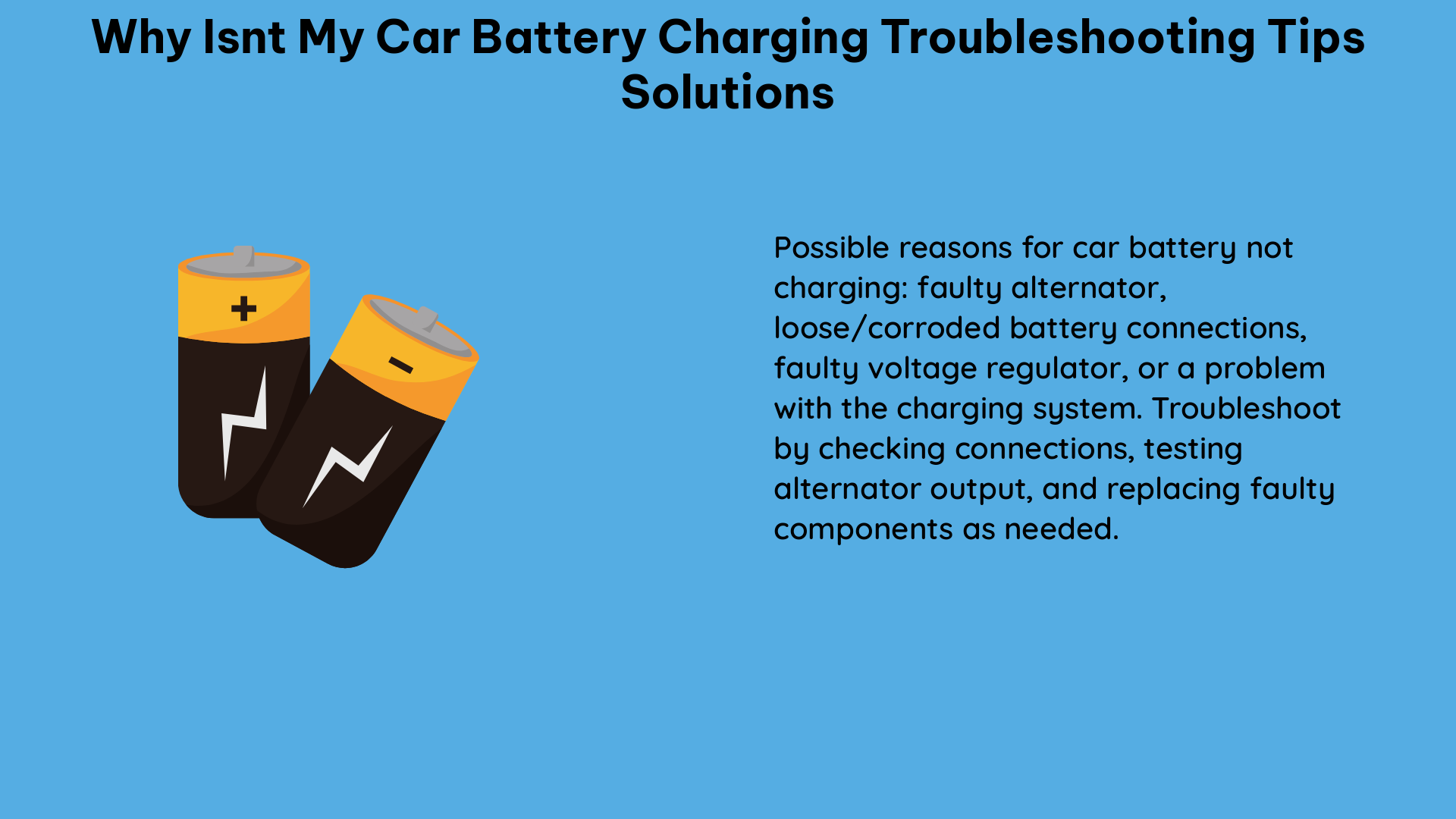Car battery charging issues can be caused by various factors, including corrosion, alternator problems, battery age, extreme temperatures, blown fuses, and parasitic drains. Here’s a comprehensive guide to help you diagnose and fix the problem.
Checking the Battery Cables and Terminals for Corrosion
Corrosion can prevent the battery from charging properly. If you notice any corrosion on the battery cables or terminals, it’s essential to clean them thoroughly. Use a wire brush and a baking soda solution to remove the corrosion. Make sure to clean both the positive and negative terminals, as well as the cable connectors. Once the cleaning is complete, apply a thin layer of dielectric grease to the terminals to prevent future corrosion.
Testing the Alternator

The alternator is responsible for charging the battery while the engine is running. If the alternator is not working correctly, the battery won’t charge. You can test the alternator using a multimeter. Start by disconnecting the negative battery cable and setting the multimeter to the DC voltage setting. With the engine running, touch the positive probe to the positive battery terminal and the negative probe to the negative terminal. A healthy alternator should produce between 13.5 and 14.5 volts.
Checking the Battery Voltage
Use a multimeter to check the battery voltage. A fully charged battery should read around 12.6 volts. If the voltage is lower, the battery may need to be charged or replaced. Keep in mind that the battery voltage can be affected by factors such as temperature and the age of the battery.
Checking for Parasitic Drains
Parasitic drains can cause the battery to drain even when the car is off. To check for parasitic drains, disconnect the negative battery cable and set the multimeter to the lowest current setting. Touch the positive probe to the positive battery terminal and the negative probe to the negative terminal. If the multimeter reads anything other than zero, you have a parasitic drain that needs to be addressed.
Checking the Fuses
A blown fuse can prevent the charging system from working properly. Check the fuses in the fuse box and replace any that are blown. Refer to the owner’s manual or the fuse box diagram to identify the correct fuse for the charging system.
Checking the Battery Cables for Loose Connections
Loose connections in the battery cables can prevent the charging system from functioning correctly. Make sure all the connections are tight and secure. You can use a wrench to tighten the cable connectors if necessary.
Checking the Drive Belt
If your car has a drive belt, make sure it’s not loose or worn out. A loose or worn-out belt can prevent the alternator from charging the battery effectively.
Checking the Voltage Regulator
The voltage regulator controls the amount of voltage that is sent to the battery. If it’s not working properly, the battery may not charge. You can test the voltage regulator using a multimeter. Refer to the owner’s manual for the specific testing procedure.
Checking the Computer System
Modern cars have computer systems that control the charging system. If the computer system is not working correctly, the charging system may not function as intended. In this case, you may need to take the car to a mechanic for further diagnosis and repair.
Checking the Battery Temperature
Extreme temperatures, both hot and cold, can affect the battery’s ability to hold a charge. If the battery is exposed to extreme temperatures, it may not charge properly. Try to keep the battery in a temperate environment to ensure optimal charging performance.
Technical Specifications
Here are the key technical specifications for a car battery:
- Voltage: Most car batteries are 12 volts.
- Cold Cranking Amps (CCA): This measures the battery’s ability to start the engine in cold temperatures. The higher the CCA rating, the greater the battery’s starting power.
- Reserve Capacity (RC): This measures the battery’s ability to power the car’s electrical systems when the engine is off.
- Amp-Hour (Ah): This measures the amount of electrical energy the battery can store.
- Physical dimensions: The battery’s physical dimensions, including length, width, and height, are also important.
DIY Solutions
Here are some DIY solutions for troubleshooting car battery charging issues:
- Clean the battery terminals and cables: Use a wire brush and baking soda solution to clean the terminals and cables.
- Charge the battery: Use a battery charger to charge the battery. Make sure to follow the manufacturer’s instructions.
- Replace the battery: If the battery is old or damaged, you may need to replace it.
- Check the alternator belt: If your car has an alternator belt, make sure it’s not loose or worn out.
- Check the fuses: If a fuse is blown, replace it.
- Check the computer system: If the computer system is not working properly, you may need to take the car to a mechanic.
References
- How to Fix a BATTERY CHARGER That WON’T CHARGE – YouTube
- What Does Battery Not Charging Mean? – Hillmuth Auto Care
- Car Battery won’t charge after sitting for a Year – Mechanics Stack Exchange
- 8 Reasons Your Car Battery Won’t Hold A Charge – Telle Tire
- Troubleshooting: Common Charging System Issues and Causes – Haynes

The lambdageeks.com Core SME Team is a group of experienced subject matter experts from diverse scientific and technical fields including Physics, Chemistry, Technology,Electronics & Electrical Engineering, Automotive, Mechanical Engineering. Our team collaborates to create high-quality, well-researched articles on a wide range of science and technology topics for the lambdageeks.com website.
All Our Senior SME are having more than 7 Years of experience in the respective fields . They are either Working Industry Professionals or assocaited With different Universities. Refer Our Authors Page to get to know About our Core SMEs.